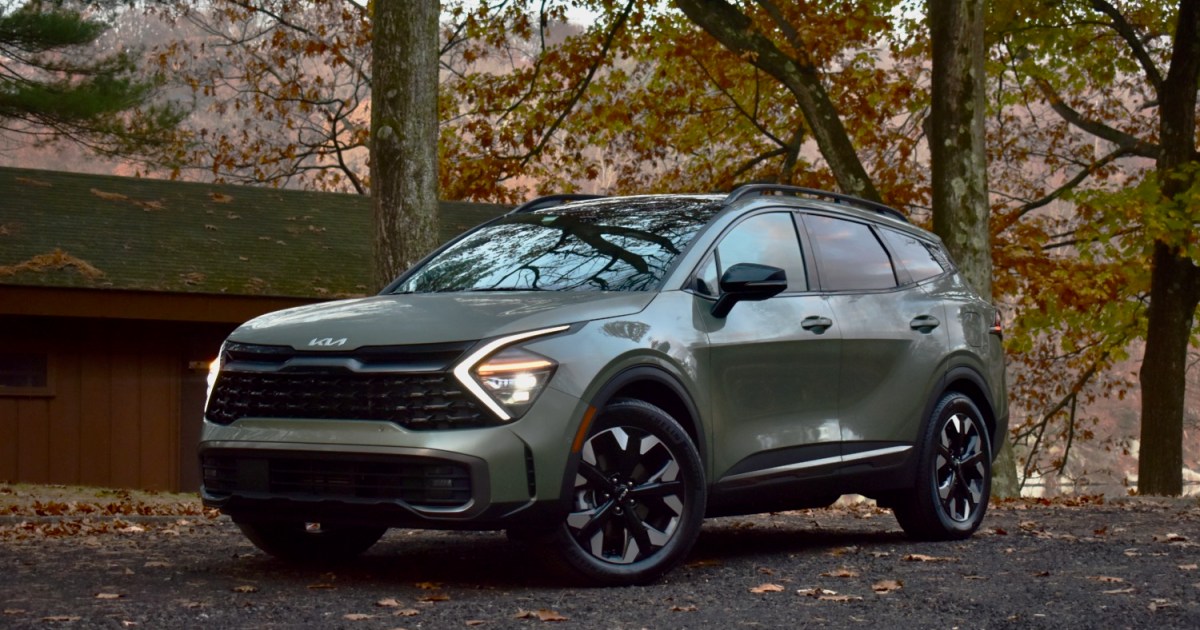2024 Kia Sportage PHEV review: a practical and stylish plug-in hybrid
MSRP $45,485.00
“The Sportage works well as a plug-in hybrid, but its interior and chassis tuning need improvement.”
Pros
- Distinctive styling
- Usable electric range
- Competitive interior space
- Intuitive interface
Cons
- Unpleasant driving dynamics
- Cheap interior materials
- Lacks wireless Apple CarPlay/Android Auto
While there’s a lot of pressure to quickly introduce all-electric versions of popular vehicle types like pickup trucks and compact crossover SUVs, it’s sometimes easier to do that with plug-in hybrids, as the transformation can be as simple as adding a bigger battery pack to a vehicle that may have already been a hybrid.
That’s exactly what Kia did to create the Sportage PHEV. Short for Plug-in Hybrid Electric Vehicle, the PHEV was introduced as part of the Sportage’s most recent redesign for the 2023 model year. Like other Kia plug-in hybrids, it features an upsized battery pack and more powerful electric motor, but has the same basic layout as its hybrid counterpart.
One of the automaker’s longest-running nameplates, the Sportage has evolved, along with the Kia brand itself, from a joke to one of the best well-regarded names among new car buyers. The 2024 Kia Sportage PHEV continues that evolution by offering a plug-in hybrid option to match other popular crossovers like the Ford Escape, Hyundai Tucson, and Toyota RAV4.
2024 Kia Sportage PHEV: design
With the current-generation Sportage, Kia took more styling risks than most rivals. Designers gave the Sportage an alien-looking face defined by diamond-shaped headlights, boomerang-like daytime running lights, and a dual-level grille that nicely camouflages how broad the front end actually is. Plug-in hybrid models wear all of these styling features; the only difference between the PHEV and the hybrid and non-hybrid Sportage models is an extra opening for the charge port.
The rest of the exterior conveys the substantial feel of a true SUV without resorting to clichés of ruggedness like the Toyota RAV4. The fenders are pulled out from the body, which, along with thin horizontal taillights, conveys a sense of width. That combines with an SUV-appropriate ride height and a fairly long wheelbase to give the Sportage a surprising amount of presence, as well as good proportions.
The Sportage has the substantial feel of an SUV without any clichés of ruggedness.
Interior space is fairly close to other versions of the Sportage, but the plug-in hybrid isn’t available with the dual-level cargo floor offered in non-hybrid and hybrid models. Its maximum 34.5 cubic feet of cargo space behind the rear seats and 65.5 cubic feet behind the front seats is also a smidge less than the Sportage hybrid, and appreciably less than what you get in a non-hybrid Sportage. Because the plug-in hybrid can only be ordered with a sunroof, it also effectively sacrifices a bit of headroom. The Sportage PHEV is still competitive with similar-sized plug-in hybrids, although the Mitsubishi Outlander PHEV offers an occasional-use third row as well.
Our test car was an X-Line Prestige, the higher of two trim levels available with the plug-in hybrid powertrain. But the interior was a reminder that the Sportage is still at the lower end of the Kia SUV hierarchy. It had plenty of cool details, including a nicely integrated curved dashboard screen and air vents that referenced the shape of the headlights. But the molded plastic door panel trim and equally plasticky fake wood on the dashboard made for a bargain-basement feel that contrasted with the premium look. And while there was indeed plenty of space in both rows, the seats themselves proved uncomfortable for longer trips.
2024 Kia Sportage PHEV: specs
| Length | 183.5 in |
| Width | 73.4 in |
| Height | 66.9 in (with roof rails) |
| Wheelbase | 108.5 in |
| Headroom (front/rear) | 37.8 in/38.0 in |
| Legroom (front/rear) | 41.4 in/39.5 in |
| Cargo space (rear seats up/down) | 34.5 cubic feet/65.5 cubic feet |
| Powertrain | 1.6-liter turbocharged inline-four engine, electric motor, six-speed automatic transmission, 13.8-kilowatt-hour battery pack |
| Horsepower | 261 hp |
| Torque | 258 lb-ft |
| Fuel economy | 35 mpg combined |
| All-electric range | 34 miles |
| Price | $40,985 (X-Line)
$45,485 (X-Line Prestige) |
2024 Kia Sportage PHEV: tech

All Sportage PHEV models have a 12.3-inch touchscreen, while the higher-level X-Line Prestige adds a 12.3-inch digital instrument cluster that blends with the touchscreen to form one long, curved display. Apple CarPlay and Android Auto are standard, but wireless versions aren’t available.
Aside from needing to keep a USB cable handy, it’s hard to fault this infotainment system. Kia’s graphic design is both distinctive and intuitive, and the main touchscreen is very responsive. That’s important, as Kia does require you to swipe across multiple screens’ worth of icons for different functions, instead of offering the tile-based interface some automakers have shifted to. A large wireless charging pad also keeps phones secure, although it’s hard to get a phone to lay flat while plugged in for use with Apple CarPlay or Android Auto.
Kia’s graphic design is both distinctive and intuitive.
As with other recent Kia models, the row of knobs and touch controls below the main touchscreen does double duty, switching between audio and climate control functions. While this does make it possible to accidentally crank up the volume when you mean to adjust the temperature, the setup didn’t cause any real issues in my experience. It also contributes to the clean look of the dashboard.
Plug-in hybrids receive the same standard driver aids as other Sportage models, including expected features like forward-collision warning and lane-keep assist. Unlike some competitors, Kia does not include adaptive cruise control as standard equipment, although its optional system includes stop-and-go functionality that will bring the car to a complete stop in traffic and restart without driver intervention. Also optional is Kia’s excellent blind-spot camera system, which displays camera images in the digital instrument cluster, and a 360-degree camera system with impressively crisp imagery that takes the guesswork out of parking maneuvers.
2024 Kia Sportage PHEV: driving experience

Like the Sportage Hybrid, the Sportage PHEV has a 1.6-liter turbocharged four-cylinder engine under its hood that’s connected to a six-speed automatic transmission with an integrated electric motor. But that motor makes 89.7 horsepower, compared to 59.3 hp in the standard hybrid. The battery pack is also bigger, at 13.8 kilowatt-hours, up from the standard hybrid’s 1.4 kWh.
The bigger pack provides enough capacity for meaningful electric range, while also necessitating the charge port that is the plug-in hybrid’s defining feature. And the more powerful electric motor contributes to a total system output of 261 hp, which is 34 hp more than the standard hybrid. Torque remains unchanged, however, at 258 pound-feet. So does the maximum towing capacity of 2,000 pounds.
The driver and passengers will spend a lot of time getting bounced around.
Equipped with standard all-wheel drive, the Sportage PHEV had quick and drama-free acceleration off the line, making good use of its electric motor’s instantly available torque. The Kia didn’t feel quite as quick as the Toyota RAV4 Prime, which dials in a little extra oomph to make buyers feel better about their plug-in hybrid purchase. The transition between all-electric and hybrid mode also could have been smoother, as the Sportage seemed to bog a bit as the gasoline engine kicked on (switching to Sport mode helped smooth this out a bit). The transmission’s shifts also seemed a bit rougher than in the Sportage Hybrid.
That wasn’t the only area where the Sportage PHEV fell short. While the standard hybrid is very pleasant to drive, albeit not very exciting, the PHEV is a chore. It took unusually long for the plug-in hybrid to get settled after rounding a corner or going over a bump, meaning the driver and passengers will spend a lot of time getting bounced around for no reason. And while most recent Kia models feature excellent steering, the Sportage PHEV isn’t one of them. Its helm is a throwback to the bad old days when most automakers couldn’t be bothered to give their mainstream models precise steering.
2024 Kia Sportage PHEV: EV range, charging, and gas mileage

The Sportage PHEV manages up to 34 miles of all-electric range, which is a bit short of the 42 miles offered by the Toyota RAV4 Prime, but in line with other competitors. It’s also easy to make use of that range. The gasoline engine will turn on under a heavy foot, but it’s not on a hair trigger. The electric motor also provides enough power to keep the Sportage moving at moderate speeds without sluggish acceleration.
Kia said a full recharge would take about two hours using a 240-volt Level 2 AC charging station, and that proved accurate despite using a relatively low-power station. That charging time, combined with the Sportage’s 34 miles of range, should make all-electric driving fairly achievable for daily commuters. The lack of DC fast charging will likely mean relying more on the gasoline engine for road trips, but that’s also the case with most other plug-in hybrids.
The Sportage also gets reasonable fuel economy in hybrid mode, at 35 mpg combined. In mixed driving, while making sure to keep the battery pack topped up, we saw an indicated average of around 44 mpg after a week with the Sportage.
2024 Kia Sportage PHEV: How DT would configure this car

Kia only offers the Sportage PHEV in X-Line and X-Line Prestige specs, but you’ll need to upgrade to the latter to get the full array of driver aids and the curved dashboard display. An upgraded Harman Kardon audio system is standard on the X-Line Prestige as well.
X-Line Prestige pricing starts at $45,485, or $4,500 more than the base X-Line model, which in turn is just over $2,000 more than the most expensive Sportage Hybrid. That lower price, along with better driving dynamics, make the hybrid a better choice overall — especially if you don’t have a home charging setup.
If a plug-in hybrid is a must, though, the Sportage PHEV makes sense in the context of its rivals. It costs about the same as the mechanically identical Hyundai Tucson Plug-In Hybrid, and offers equally generous warranty coverage. The Ford Escape Plug-In Hybrid has slightly more electric range, but is only available with front-wheel drive. The Mitsubishi Outlander PHEV impresses with EV-like driving dynamics, but its infotainment system falls short of Kia’s.
But Kia shoppers should seriously consider the Toyota RAV4 Prime. Set to be rebranded as the RAV4 Plug-In Hybrid for the 2025 model year, it falls within the same price range as the Sportage PHEV, but offers more electric range, a better driving experience, and wireless Apple CarPlay and Android Auto. While the Sportage PHEV has a lot of good points, the RAV4 performs the same role better.
Read the full article here













